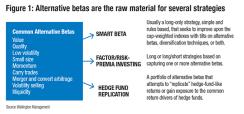To view a PDF of this report click here
While much has been written recently about smart beta, alternative beta, and factor investing, some important issues have received scant attention, including historical perspective (how much is really new?), the active decisions inherent in these “passive” strategies, and the difficulty in capturing factor premia in real-world portfolios.
The new paradigm
Alternative betas or factor premia are systematic sources of return that arise from breaking down an asset class like equities into common drivers of return that are subordinated to the market beta or risk premium. These alternative betas are the raw material used to build “new” strategies. Whether it’s a lower-octane strategy like smart beta or a higher-octane hedge-fund-like strategy, the building blocks are the same (Figure 1).

What’s old is new
Alternative betas are also the building blocks for many quantitative strategies, and have been the preoccupation of academics and quantitative practitioners for decades. Factor-based investment strategies originated in the 1970s with the first index fund based on the king of all factors, the market factor. Low-volatility strategies were first proposed in the early 1970s. From the late 1970s to the early 1990s, value, size, momentum, currency carry, and other systematic sources of return were documented and used in practice. Style indexes were born. So while the terms “smart beta” and “factor investing” may be new, related strategies have existed for almost 50 years.
Why all the interest now?
Many of these ideas are now being repackaged to capitalize on investor interest in simplicity, transparency, and lower fees. Additionally, appreciation for the role of factors in asset-class returns has grown. The financial crisis highlighted factors’ roles in markets and the need to explicitly manage attendant risks. Asset owners are increasingly aware that, as with market beta, factors may not be diversified away when investing across multiple managers.1 Factors or alternative betas are increasingly recognized as a form of beta or premia sometimes masquerading as alpha, yet plans are paying fees more appropriate for true alpha. The old two-tier model of market beta and pure alpha is being replaced with a three-tier model of asset-class beta, alternative betas, and true alpha. Alternative betas require more skill than market beta but less than true alpha, and should be priced accordingly. Many investment plans are understandably interested in improving returns, risk, and costs by more explicitly allocating to alternative betas.
Alternative betas or systematic sources of return have other appealing attributes:
• They are intuitive and easy to describe, rather than being “black-box.”
• Returns can be attributed to factors, disentangling luck from skill.
• Factors may offer diversification benefits beyond asset-class diversification.
• As with equity beta, some factors have been challenged during recessions but have otherwise been good long-term investments.
It may be beta, but is it passive?
Some alternative betas are now being positioned as premia, like the equity risk premium. If equity beta can be a passive investment, surely sub-asset-class betas can too. But passive investments represent consensus views and are unambiguous and highly liquid. Smart beta and alternative betas represent non-consensus views, are highly ambiguous, and vary in terms of liquidity.
Non-consensus
The average investor’s return is defined by the cap-weighted indexes, against which active management is irrefutably a zero-sum game (negative after trading costs). For every overweight there must be a corresponding underweight over the aggregate sum of market values, just as every tilt toward a factor must have an offsetting tilt away from it. Indexes based on weighting schemes other than market values are, at least to some degree, active management with a non-consensus view. If they are structured with some characteristics of an index — transparency and low turnover, for example — this may blur the line between passive and active, but they still express a non-consensus expectation. It’s difficult to imagine a world where the cap-weighted index does not provide a guidepost or benchmark reference: It is by definition the average investor’s experience against which these strategies should be judged on dimensions of both risk and return.
Non-consensus return expectations may vary, of course, as trades become more popular. As economist Jeremy Stein noted, “For a broad class of quantitative trading strategies, an important consideration for each individual arbitrageur is that he cannot know in real time exactly how many others are using the same model and taking the same position as him. This inability of traders to condition their behavior on current market-wide arbitrage capacity creates a coordination problem and, as I show further, in some cases can result in prices being pushed further away from fundamentals.”2 Stein is commenting on some of the lessons learned about crowded trades in 2007 and 2008, when too many equity managers had similar processes and overlapping holdings. Yet some smart-beta and similar strategies are moving in the opposite direction, toward commoditization and the desire to grow assets to that of a cottage industry.
Ambiguous
Bets against the consensus require myriad decisions: the factors, their definitions, and their weights; position weights and portfolio construction techniques; trading strategies and turnover; and the investable universe of stocks. For example, the choice of a proxy for measuring value, such as book-to-price versus earnings yield, has had material short- and long-run return consequences. There is no consensus on the best definition of the value premium.
Liquidity
Many common alternative betas have historical Sharpe ratios that are higher than the equity market.3 “Why is everyone so enamored with the equity risk premium when these factors have better Sharpe ratios?” was a question I heard at a conference a few years ago. The challenge has to do with real-world frictions. The equity premium is easy to capture with the liquidity and low costs of cap-weighted indexes. Alternative betas are much more elusive in the real world. Factoring in shorting fees has a material impact on long/short profitability. Many factors are more effective in smaller stocks and in less-liquid markets, such as those in the developing world. Some factors, like momentum, require more turnover and cost more to trade. Liquidity issues are paramount to successfully capturing factor premia.
Competition is inevitable, regardless of whether smart beta and factor investing are considered new or old (though I believe most of these concepts are quite old). Weaker players will lose to those who can trade more efficiently, define and combine factors more effectively, and better manage unrewarded risks — all of which is active management, whether it’s called smart beta, factor investing, or quantitative equity.
By Don Tunnell
Director of Quantitative Research and Co-Director of Quantitative Investments
Wellington Management
This material and/or its contents are current at the time of writing and may not be reproduced or distributed in whole or in part, for any purpose, without the express written consent of Wellington Management. This material is not intended to constitute investment advice or an offer to sell, or the solicitation of an offer to purchase shares or other securities. Investors should always obtain and read an up-to-date investment services description or prospectus before deciding whether to appoint an investment manager or to invest in a fund. Any views expressed herein are those of the author(s), are based on available information, and are subject to change without notice. Individual portfolio management teams may hold different views and may make different investment decisions for different clients.




